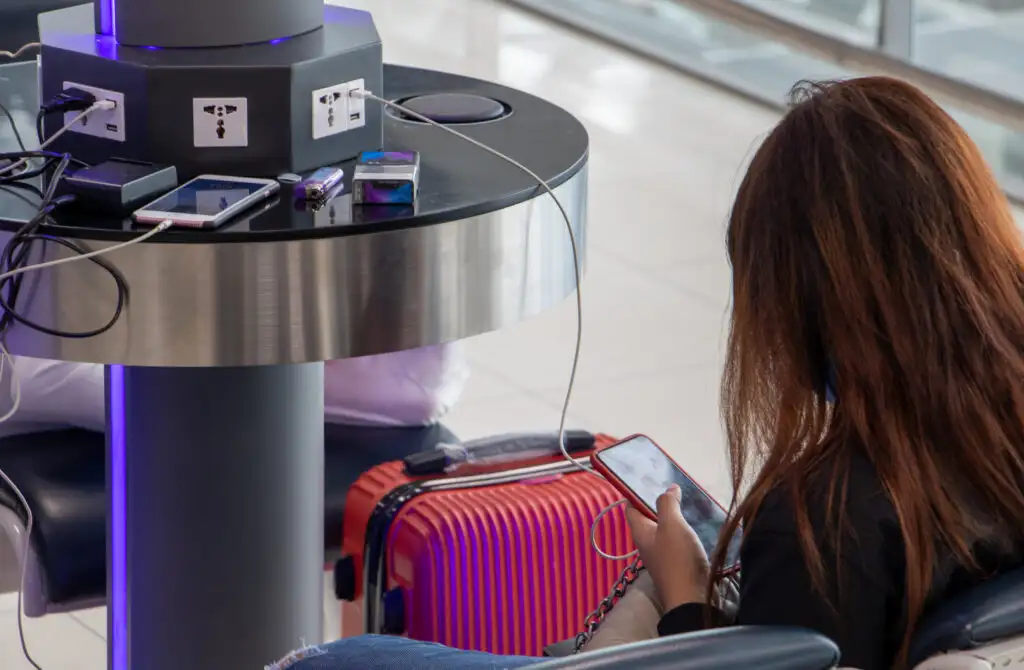Your phone is on two percent battery and you’re stuck at the airport due to a delayed flight, when you see your saving grace—a free charging station at the gate! We’ve all been there, and we’ve all used them, especially while traveling, and you probably didn’t think twice about plugging in. Well, you should.

What is Juice-Jacking?
“Juice jacking,” as the travel scam is called, targets desperate travelers in need of a charge. Daniel Smith, a security researcher at Radware explains how this works. “Attackers can use fake charging stations to trick unsuspecting users into plugging in their device. Once the device is plugged in the user’s data and photos could be downloaded or malware can be written onto the device.”
Hackers can download anything that is on your phone, since the charging port is doubling as a data port. We’re talking passwords, emails, photos, messages, and even banking and other personal information via apps.
There have been several campaigns to increase public awareness about the scam since 2011, when the term juice-jacking was first coined by investigative journalist Brian Krebs. This past April, the FBI Denver official Twitter account tweeted a warning stating that “bad actors have figured out ways to use public USB ports to introduce malware and monitoring software onto devices” and that travelers should avoid using unknown charging cables and plugging directly into public USB ports.
Sounds scary right? While it never hurts to be protective of your personal data while traveling, how worried should you really be about juice jacking at the airport?
How Common is Juice-Jacking?
With all the official warnings cropping up over the past decade, it’s easy to assume that hackers are draining your data every time you enter the terminal. However, it seems that anxious travelers can breathe a small sigh of relief.
“There are no documented cases of juice jacking ever taking place in the wild,” says Dan Gooden, Senior Security Editor at Ars Technica, “Left out of the advisories is that modern iPhones and Android devices require users to click through an explicit warning before they can exchange files with a device connected by standard cables.”
Even though the likelihood of becoming a victim of juice-jacking is low, there are easy ways to eliminate the risk altogether.
How to Prevent Juice-Jacking
If you find yourself always on low battery and relying on public charging stations, there are products out there that will protect your phone data while charging in public spots.Consider purchasing a super tiny data blocker, which is a “USB defender” that protects any data from being stolen off of your phone.
Avoid public charging stations altogether by investing in your own personal portable battery pack. You won’t need to fight for space at the charging station or hunt down an errant outlet in the terminal. You can also charge your phone on the plane, bus, train, car, or while walking around outside where outlets are not readily available.
Best Portable Cell Phone Chargers
The best portable battery packs are lightweight, hold at least one to two full smartphone charges before needing a recharge, and are TSA-compliant (operating below 100 watt hours or 27,000mAh).
Biolite PD Charge 20
The Biolite Charge 20 PD is the smallest model from the Biolite Charge series. It charges via USB–C (in/out port), features two USB-A charge-out ports, and will charge a standard smartphone 1.5 times.
iWalk Small Portable Charger
This ultra-small portable charger is perfect for iPhone users with limited luggage space. It fits easily inside a pocket or small purse and is compatible with iPhone model 6s through 14 Pro Max.
Anker Portable Charger
Despite its small size, the Anker Portable Charger packs a powerful punch, charging a smartphone up to 2.5 times (make and model dependent) before needing to be recharged.
Carol McPherson contributed to this story.
All of the products featured in this story were hand-selected by our travel editors. Some of the links featured in this story are affiliate links, and SmarterTravel may collect a commission (at no cost to you) if you shop through them.
You Might Also Like:
• The Best and Worst US Airlines for Lost Luggage• Is Amazon Prime Day Worth it for Travelers?
• The 13 Best Hotel Booking Sites
• The Ultimate Guide to Online Check-In for Flights
• Flight Price Trackers: 6 Sites That Will Find the Cheapest Airfare for You
We hand-pick everything we recommend and select items through testing and reviews. Some products are sent to us free of charge with no incentive to offer a favorable review. We offer our unbiased opinions and do not accept compensation to review products. All items are in stock and prices are accurate at the time of publication. If you buy something through our links, we may earn a commission.
Related
Top Fares From
Today's Top Travel Deals
Brought to you by ShermansTravel
France: 8-Night Paris, Avignon & Nice...
Infinity Worldwide Vacations
 vacation
$2880+
vacation
$2880+
Poconos: 3 Nts in Garden of...
ResortsAndLodges.com
 hotel
$305+
hotel
$305+
7-Nt Canada & New England Cruise,...
Princess Cruises
 cruise
$839+
cruise
$839+




